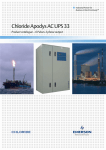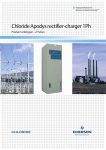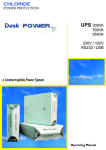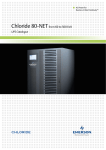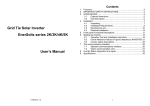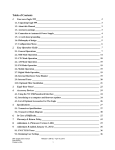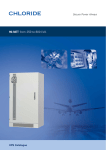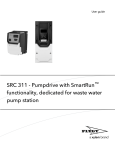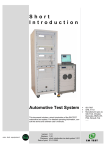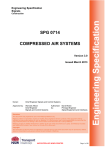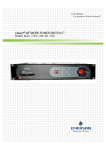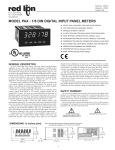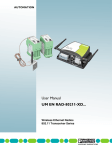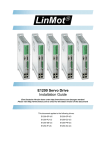Download UPS APODYS E-CATALOGUE-UK-Rev3-02-2012
Transcript
Industrial Power for Business-Critical ContinuityTM Chloride Apodys-E AC UPS 31 & 33 Product catalogue — 6 or 12 Pulses-1 or 3 phase output Chloride Apodys-E AC UPS Uninterruptible Power Supply System 3-phase input — 6 or 12 Pulses - 1- or 3-phase output Scope 4 General requirements 4 Range overview 5 System description 6 Monitoring and control interfaces 9 Mechanical data 14 Environmental conditions 14 Technical data 15 Parallel operation 24 Options 27 General arrangement drawings 30 Chloride ApodysApodys-E AC UPS 1 Scope This document describes a continuous duty three phases Alternating Current (AC) input, stand-alone, three-phase or onephase AC output Uninterruptible Power System (UPS). The Apodys-E UPS range meets customers’ technical specifications for industrial applications such as petrochemical plants, oil and gas offshore developments (platforms, FPSO, etc…), power generation plants, mining, water desalination and treatment plants, aluminium smelters, other manufacturing plants (glass, steel...). The Apodys AC UPS range is part of Chloride’s know-how and longtime relationship with industrial businesses. Chloride Industrial Power services include: • Consultancy services • Pre-engineering design and support • Project Management (contract management, detailed engineering, documents for approval, manufacturing, product testing, witnesstesting if requested, shipment, tailored user manual) • Services (recommended commissioning spare parts, commissioning services, product lifetime spare parts, hotline, trainings, maintenance contracts, etc…) 2 General requirements 2.1. ISO certification Chloride France S.A. is certified by the British Standard Institution (BSl), as a company with a total quality and environmental control system in accordance with the ISO 9001 and ISO 14001. • • • 2.2. Applied standards The Apodys-E AC UPS range shall have the CE mark in accordance with the Safety and EMC Directives 2006/95/EC and 2004/108/EC. The Apodys-E AC UPS range is designed and manufactured in accordance with the following international standards: • IEC60146 Semi conductor converters: − IEC60146-1-1 specifications of basic requirements − IEC60146-1-3 transformers and reactors − IEC60146-2 self-commutated semiconductor converters including direct dc converters. • IEC60950 Safety of information technology equipment including electrical business equipment • IEC60439 Low voltage switchgear and control gear assemblies − IEC60439-1 Type-tested and partially type-tested assemblies − IEC60439-2 Particular requirements for busbar trunking systems (busways) − IEC 60439-3 Particular requirements for LV switchgear and control gear assemblies intended to be installed in places where unskilled persons have access 4 • for their use — distribution boards IEC60529 Degrees of protection provided by enclosures (IP Code) IEC60726 Dry-type power transformers EN61000-6-2 Electromagnetic compatibility (EMC) Generic standards — Immunity for industrial environments IEC61000-6-4 Electromagnetic compatibility (EMC) Generic standards — Emission standard for industrial environments. Chloride ApodysApodys-E AC UPS 3 Range overview The system described is a static UPS system as shown in Figure 1. The system operates on a microprocessor-based thyristors (SCR’s) rectifier and microprocessor-based IGBTs inverter. By means of digital vector control technology the performance of the UPS are enhanced. By adding system components, such as paralleling kits, safety and disconnecting devices, distribution cubicles, as well as software and communications solutions, it is possible to set up elaborated systems ensuring complete AC load protection. The UPS uses the double conversion topology. It converts AC power from an AC source into DC power to charge a battery and reconverts it into AC power to provide a clean and reliable AC output to power the AC load. 3.1. The system The UPS provides high quality AC power for electronic equipment loads. It offers the following features: • Increased AC power quality • High input power factor • Full compatibility with all types of loads • Power blackout protection (for systems associated with battery) • Lifetime of, at least, 20 years, combined with an appropriate preventive maintenance • Operation temperature of 0 to 40°C permanent. 3.2. Models available The Apodys-E UPS range includes several kVA ratings output models as specified in paragraph 8. It is of the single- or threephase output type. Bypass cubicle -Q31 RESERVE SUPPLY UPS cubicle DISPLAY Ucc -Q21 U, F -V21 U, F Rectifier/charger + Inverter U, I, F -T11 -T3 -Q3 A -Q21 Contact A B C Position 1 0 1 AUTO 1 0 1 TRANSITION 0 1 1 TEST MAINTENANCE 0 1 0 I,U -F5 Battery fused switch BYPASS SWITCH OPERATION * Legend: * B U, F, I, W AC SUPPLY 3-PHASE BATTERY C -V18 Interconnection cables not supplied by Chloride Figure 1: APODYS-E UPS single line diagram 5 -Q24 AC LOAD 1-PHASE OR 3-PHASE Chloride ApodysApodys-E AC UPS 4 System description In this section, the main power electronic features and the operating modes of the Apodys-E UPS range are described. 4.2. Components The UPS consists of the following major components: • One input isolator • One input transformer • One SCR rectifier • One IGBT charger/booster converter • One IGBT inverter module • One output transformer • Electronic static switches • Manual bypass switch • Two control units, each based on one microprocessor and one Digital Signal Processor-DSP • One control and visualisation unit 4.1. General description The three-phase current taken from the AC source is converter to a regulated DC voltage by a 6or 12-pulse SCR (SiliconControlled Rectifier). In order to protect the power components within the system, the rectifier bridge is fused with a fast acting fuse. A transformer is provided at the input of the rectifying bridge. The DC current taken from the rectifier is converted to a sinusoidal and regulated AC voltage by an IGBTs inverter (Insulated Gate Bipolar Transistor), using PWM (Pulse Width Modulation). This means that the digital signal processor controls the IGBTs so that the DC input voltage is divided into pulsed voltage to generate a low distortion sinewave AC output voltage with good transient response voltage regulation. A transformer is provided at the output of the inverter bridge. 4.3. Operating modes The Apodys-E UPS operates as follow: 4.3.1. Normal operation The critical AC load is continuously supplied by the UPS inverter. The rectifier-charger derives power from the AC source and converts it into DC power for the inverter whilst simultaneously maintaining the battery in a fully charged and optimum operational condition (floating mode). time (s) 1000 800 600 The inverter converts the DC power into clean and regulated AC power to supply the critical load through the static transfer switch. The power loading can reach up to 105% of the inverter nominal rating without considering the inverter in overload conditions. While supplying the load, the inverter and static switch control unit monitors the reserve supply signal and ensures that the inverter bridge tracks the reserve supply frequency. Thus, any automatic transfer to the reserve supply (e.g. when an overload is detected) is frequency synchronised and does not cause an interruption to the load. 4.3.2. Overload operation The UPS inverter is considered in overload conditions when the load is beyond 105% of the inverter nominal rating. Two cases are considered: Case 1: Reserve supply is available: • Upon overload detection by the UPS inverter (above 105% of the inverter nominal rating), the static switch automatically transfers the load to reserve supply. The static switch automatically switches back the load to inverter 10 seconds after the UPS inverter is back to normal conditions. 400 The reserve supply withstands overload as shown on Figure 2. 200 100 110 120 130 140 150 Overload (in %) Figure 2: Reserve supply overload withstanding curve 6 Chloride ApodysApodys-E AC UPS Case 2: Reserve supply iiss not available: • Upon overload detection by the UPS inverter (above 110% and up to 125% of the inverter nominal rating): − The system initiates a timer for a 10 minutes period. − The AC load remains powered by the UPS inverter for this 10 minutes period. − Upon expiration of the 10 minutes delay, the UPS inverter shuts down. • Upon overload detection by the UPS inverter (above 125% and up to 150% of the inverter nominal rating): − The system initiates a timer for a 1 minute period. − The AC load remains powered by the UPS inverter for this 1 minute period. − Upon expiration of this minute delay, the inverter shuts down. • Upon overload detection by the UPS inverter above 150% of the inverter nominal rating: − The UPS inverter keeps powering the AC load for 5 seconds after which it automatically shuts down. 4.3.3. Input supply failure Upon fault of the input AC source, the rectifier-charger stops while the load remains supplied by the UPS inverter. Upon Mains input fault detection, the inverter immediately draws its power from the associated battery without switching. While the inverter is powered by the battery, indication is provided of the actual autonomy percentage remaining. When reaching the end of battery autonomy, an alarm occurs and the static switch immediately switches the load onto reserve supply, without interruption. If for any reason, the reserve supply is not present or faulty and the battery is no longer available, the UPS automatically shuts down. This overload operation mode is shown in Figure 3. time (s) 10 min 100 s 1 min 10 s 5s 4.3.4. Battery recharge operation After an AC input failure and upon its restoration, the rectifiercharger can be pre-set (according to customer’s specification) to automatically restart in 2 ways: 1) Timer Recharge Mode: ode: If the Mains input failure was longer than 5 minutes, the rectifier charger automatically restarts in recharge mode for the pre-set recharge time. If the Mains input failure was less than 5 minutes, the rectifier-charger automatically restarts in floating mode. 2) Current Recharge Mode: For any Mains input failure duration, the rectifier-charger restarts in recharge mode until the battery current is below a pre-set value. Then, the rectifiercharger automatically turns to floating mode. 3) Equalization mode This operating mode is a specific mode dedicated to vented type batteries. It is used when boost charge or initial charge is requested. During Equalization mode, the voltage limitation is increased (up to 2.65V per cell for a Lead Acid battery and up to 1.7V per cell for a Nickel Cadmium battery). Restoration of the Floating mode is automatic after a preset typical time of 5 hours, unless the Floating mode is manually initiated by the operator through the control unit. 4.3.5. Maintenance bypass operation 100 125 150 Overload (in %) Figure 3: Apodys-E AC overload curve 7 If for any reason the UPS has to be taken out of service for Chloride ApodysApodys-E AC UPS maintenance or repair, the Apodys-E UPS is provided with a manual bypass switch. The bypass switch enables a load transfer to reserve supply without power interruption for the load. Bypass isolation is then complete, all serviceable components such as fuses, power modules etc. are isolated. The transfer/retransfer is based on the make-before-break principle in order to secure the critical load: the transfer/retransfer operation is automatically accomplished by paralleling and synchronising the inverter output to the reserve supply, before closing or opening the bypass switch as appropriate. 4.4. Electrical features 4.4.1. Total harmonic distortion of input voltage The maximum voltage THD allowed on the rectifier input is 8% to guarantee the correct operation of the system (either from utility or from generator). 4.4.2. Charger current limitation The battery charger current is limited to the nominal value either in floating, charge and equalization mode. 4.4.3. Battery current limitation The battery current is limited to 0,1C (Pb) or 0,2C (NiCd) of the associated battery, in floating or charge modes. In equalization mode, the battery current is limited to 0,05C (Pb) or 0,1C (NiCd). 4.4.4. Over voltage protection The rectifier and the charger of the UPS are automatically turned off if the DC voltage exceeds the maximum value associated to their operational status. 4.4.5. Output voltage harmonic distortion The inverter provides harmonic neutralisation and filtering to limit the total harmonic distortion on the voltage to less than 3% with a linear load. For reference non-linear load the total harmonic voltage distortion is within limits defined by EN62040-1-2. 4.4.6. Inverter short-circuit capacity The short-circuit capacity on the output of Apodys-E UPS is detailed in Figure 4 and 5 below. 4.4.7. Static Switch shortcircuit capacity The electronic static switch is capable of supporting the shortcircuit currents as shown on Figure 6. time t (ms) t (ms) 1s 5s 5s Ph-N Ph-N 100 ms 100 ms Ph-Ph 100 ms 10 ms 1 3 2 1.35 1.9 2.2 4 3.15 In (A) Figure 4: Apodys-E AC UPS 3-ph inverter short circuit capacity 1 3 2 1.75 2.5 4 In (A) Figure 5: Apodys-E AC UPS 1-ph inverter short circuit capacity 8 11 2 3 4 5 6 7 8 9 10 In (A) Figure 6: Apodys-E AC UPS reserve supply short circuit capacity Chloride ApodysApodys-E AC UPS 5 Monitoring and control interfaces The UPS incorporates the necessary controls, instruments and indicators to allow the operator to monitor the system status and performance and take any appropriate action. Furthermore, interfaces are available upon request, which allow extended monitoring and control, as well as service functions. Symbol 5.1. Light emitting diodes (LEDs) 5.2. Start and Stop push buttons The UPS includes 3 external Light Emitting Diodes (LEDs) to indicate the overall system operation status as well as the condition of the functional blocks. LEDs operation is described in Figure 7. These LEDs shall interact with the active mimic diagram displayed on the graphical display. The Start and Stop push buttons are integrated into the mimic panel board, and operate as described on Figure 8. The control incorporates a safety feature to prevent inadvertent operation yet still allow rapid shutdown in the event of an emergency. This is achieved by pressing the “STOP” button for 2 seconds before the module stops. « Rectifier OFF » or « Inverter OFF » is displayed on the LCD. LED colour Green Description UPS normal operation Comments Load supplied by inverter Green flashing Orange Load on reserve or on battery UPS warning Load powered by reserve or by battery Red UPS fault One or more subassembly are affected but not stopped Subassembly are faulty and stopped or manually stopped STOP Figure 7: Apodys-E UPS— Light Emitting Diodes (LED) operation description “System normal” LED “Warning” LED “Alarm” LED STOP C UPS OK Navigation buttons: Up and down (in menus) Valid and Cancel (parameters) Figure 8: Apodys-E AC UPS — Local human-machine interface. 9 “Rectifier ON/OFF” Push button “Inverter ON/OFF” Push button Inverter Reset audible alarm Push button (Until a new alarm occurs) Chloride ApodysApodys-E AC UPS 5.3. Display A graphical (64 x 128 pixels) illuminated Liquid Crystal Display (LCD) is provided to enable the operating parameters, all the measurements and the active mimic diagram of the UPS to be monitored. The LCD messages are accessed by navigation buttons (see Figure 8). The text is available in English, unless otherwise mentioned. By using the appropriate pushbuttons it is possible to display the information described hereafter. 5.3.1. Default page The default page displays the active mimic diagram of the UPS (see Figure 9). 5.3.2. Active mimic diagram The active mimic diagram displays the following information: • Graphical view of the connected load • Graphical view of the power flow • Graphical view of the status of each functional block The Figure 10 provides an example of an active mimic situation (1-ph output): • AC Mains input failure • Rectifier-charger stopped • Battery discharging • AC load still supplied by battery via the inverter • Reserve supply available and in stand-by mode 5.3.4. Menus of functional blocks Each functional block (rectifier, charger / battery, inverter, reserve static switch, load) includes its own menu to provide the user with detailed information, such as: • Block status • Block measures • Block faults • Block warnings By using these menus, the user can access to detailed information about each following component: • Rectifier • Charger / Battery • Inverter • Reserve supply • AC Load 5.3.5. Rectifier information Status indications: Figure 10: Active mimic panel, example of situation Figure 9: mimic default page. 5.3.3. General menu By pressing the “OK”, “UP”, or “DOWN” buttons, the user enters the general menu. If the user is navigating in the menus, he may return to the active mimic diagram by pressing the “C” button. If the user does not request any action (such as pressing a button) for 5 minutes while displaying the menus, the system will automatically return to the display of the default page active mimic diagram. Pressing any key from the default page (active mimic diagram) allows the user to access to the following general menu: • Rectifier • Charger / Battery • Inverter • Reserve supply • AC load • Reset • Black Start (option) • Event log • Display setting • Contact • About 10 Rectifier off Initialisation Rectifier Stop Normal mode Battery test mode* Battery test imposed* Test mode* Measurements indications: UDC (rectifier output voltage) IDC (rectifier output current) U12 (Input voltage ph 1 and 2) U23 (Input voltage ph 2 and 3) U31 (Input voltage ph 3 and 1) I1 (input line current) I2 (input line current) I3 (input line current) Freq (input frequency) Number of Mains failures Chloride ApodysApodys-E AC UPS Warning indications: Warnings indications: Fault indications: Test mode Fan failure DC voltage low Overload transformer warning Customised message 1* Customised message 2* Customised message 3* * Optional messages (according to specification and system configuration) DC earth fault* Battery begin discharge Imminent shutdown Temp sensor fault memorised* Charger in test mode Charger low DC voltage Customised message 1* Customised message 2* Customised message 3* * Optional messages (according to specification and system configuration) Inverter switched off VCE bridge fault memorised Inverter overload fault memorised Over temperature fault memorised Low DC voltage Repeated low DC voltage memorised High DC voltage memorised Microcontroller fault memorised High AC voltage memorised Frequency fault memorised Parallel communication fault memorised* Low AC voltage memorised* Customised message 2* Customised message 3* * Optional messages (according to specification and system configuration) Fault indications: High DC voltage High DC voltage memorised Rectifier fuse blown Input protection opened Rectifier off Rectifier remote switch off* Rectifier AC supply fault Rectifier wrong phase sequence Rectifier AC supply voltage fault Overload transformer fault Customised message 1* Customised message 2* Customised message 3* * Optional messages (according to specification and system configuration) Faults indications: Battery test fault memorised Battery protection opened* Battery high DC voltage Battery high DC voltage memorised Battery high current Charger switch off Batt End of discharge Boost high DC voltage memorised Customised message 1* Customised message 2* Customised message 3* * Optional messages (according to specification and system configuration) 5.3.6. Charger / Battery information 5.3.7. Inverter information Charger status indications: Inverter synchronised Inverter on crystal Inverter stop Waiting for stop (only in parallel)* Inverter switched off Converter stop Charger Stop Equalisation mode Equalisation imposed Floating mode Battery test mode Battery test imposed Initial charge mode Charger in test mode Status indications: Measurements indications: UDC (inverter input voltage) U (inverter output voltage) Freq (output frequency) Battery status indications: Normal Discharging Charging Warning or Fault Measurements indications: Battery voltage Battery current Battery temperature Battery autonomy (%) Warning indications: Commissioning Software time out Fan failure* Inverter overload warning Customised message 1* Customised message 2* Customised message 3* 11 5.3.8. Reserve information Status indications: No warning; no fault Warning; no fault No warning; fault Warning + fault Measurements indications: Reserve voltage Reserve frequency Warnings indications available: Reserve voltage fault Reserve frequency fault Wrong phase sequence Reserve inhibited Parallel reserve fault memorised* Customised warning message 1* Customised warning message 2* Customised warning message 3* 5.3.9. Load and static switch information Status indications: Load on inverter Load on reserve Manual bypass on Load not supplied Chloride ApodysApodys-E AC UPS Measurements indications: Load voltage Load current Load frequency Load power (in kVA) Load power (in kW) Total time on inverter Load current ratio (%) Power factor starting parallel inverters even if the reserve supply is not present. The Black Start function operates as follow: When 2 UPS systems are paralleled and the reserve supply is not present, it is possible to start both inverters simultaneously via the control panel of only one of the two inverters. Warning indications: AC earth fault* Manual bypass closed Static switch overload Customised message 1* Customised message 2* Customised message 3* Fault indications: Emergency power off* Static switch overload fault memorised Inverter static switch fault memorised Reserve static switch fault memorised Static switch hardware fault memorised AC output voltage fault* Customised load fault message 2* Customised load fault message 3* * Optional messages (according to specification and system configuration) 5.3.10. Event log The Event Log function is available through the display and allows memorising each event into the historical record, in a chronological way. The Event Log function can operate in 2 different ways: • Saturable mode: It records a maximum of 100 events after the first event appearance. • FIFO mode: After recording 100 events, the 101st event deletes the 2nd one and so on. 5.3.11. Black Start The Black Start function, as available in the display, is only for paralleled UPS systems. It allows NOTE: This function differs from the one described in the Options section. 5.4. Remote signalling and control signal 5.4.1. Logic outputs for remote indications Apodys-E is able to deliver several output information. These output information are made available on double-pole changeover (dpco) contacts (8A/250V AC1; 8A/30V DC1; 1A/60V DC1). The following information is made available on voltage-free contacts: UPS general alarm Charger fault Inverter fault Reserve supply fault Load on reserve Imminent shutdown Connection of the customer cables is achieved on the identified, screw-clamp terminal blocks of each relay-holder. 5.4.2. Logic inputs The Apodys-E range allows the signalisation of specific alarms from the customer’s environment and eventually takes the appropriate action on 12 the UPS thanks to dedicated logic inputs. As standard, the UPS includes the following input: Emergency power off Among all possible function, the following logic input can be wired upon request: Remote control on/off Chloride ApodysApodys-E AC UPS 5.5. Communication interfaces (options) 5.5.1. Isolated RS 232 link Upon request, Apodys-E can be equipped with one sub-D 9 points connector for direct (1 master, 1 slave, max 15 meters) serial RS232 communication. Shield 5.5.2. Isolated RS 485 link Upon request, Apodys-E can be equipped with 6 points socket for multipoint (1 master, up to 31 slaves, max 1300 meters) serial RS485 communication. Customer connection is easily achieved thanks to the screwclamp connector provided (see figure below). Earth connection is achieved on the PCB through a 6.35 Faston lug. 54 9 32 87 1 6 Pin assignment is described in the Table 1 hereafter. 6 7 8 9 Signal Not used Tx Rx Not used RS232 GND Not used RTS Not used Not used Explanation Transmission RS232 Reception RS232 12 Signal ground 34 5 6 Clear to send RS232 Table 1: RS232 pin assignment Pin Signal 4-wires mode 1 GND Not used 2 Tx- 3 Tx+ 4 Rx- 5 Rx+ 6 +5V Transmission RS485/ neg. Transmission RS485/ pos. Reception RS485/ neg. Reception RS485/ pos. Not used Table 2: RS 485 pin assignment Figure 11: RS 232 SubD 9 points connector Pin 1 2 3 4 5 The RS485 communication path may be used either in 4 wires mode or in 2 wires mode, as described in the Table 2 hereafter. Figure 12: RS 485 6 points connector NOTE: If simultaneous use of RS232 port and RS 485 is necessary, this will require 2 separate PCBs, one for RS232 and the other for RS485. 13 2-wires mode Not used Negative signal Positive signal Not used Not used Not used Chloride ApodysApodys-E AC UPS 6 Mechanical data 6.1. Enclosure The Apodys-E UPS is housed in a space-saving enclosure including front doors and removable panels (standard external protection IP 42). The enclosure is made of sheet steel. The doors can be locked. The enclosure is of the floor mounted type. 6.2. Ventilation Fan-assisted air cooling is standard on the Apodys-E range, exception made for few ratings which are in natural cooling. The cooling air entry is in the base and the air exit at the top of the device. It is recommended that the enclosure is installed with at least 400 mm of free space between device and ceiling at the top in order to allow an unhindered cooling air exit. 6.3. Cable entry Cable entry is achieved via the bottom of the cabinet. Top cable entry is also available in option. 6.4. Enclosure design All the surfaces of the enclosure are finished with an electrostatically applied powderepoxy-polyester coat, cured at high temperature. The coating has a thickness of 50 microns. Colour of the enclosure is RAL 7032 (pebble grey) textured semi-gloss. For uniformity of the UPS with other equipments in electrical rooms, the surface finishing and the colour of the enclosure may be tailored according to the customer’s specification and upon request. 6.5. Components identification Main components are identified by engraved traffolyte labels as standard (black characters on white background). 6.6. Cabling Internal cables are halogen-free cables. These cables are of the flame-retardant type according to IEC 332-3 standard (LSF — Low Smoke Fume). 6.7. Internal cables connection Connection of cables is achieved by inserting cables directly in screw-clamps. 6.8. Access to integrated subassemblies All internal subassemblies are accessible for typical and most frequent maintenance from the front of the unit. Top access is available for replacement of cooling fans. Rear access is not required for installation or servicing. In any case and if side or rear access is required, the side and rear panels are removable. 6.9. Installation The UPS is forkliftable from the front. Upon request, it can be equipped with lifting lugs to facilitate its installation on site. 7 Environmental conditions The Apodys-E UPS is capable of withstanding any combination of the following environmental conditions. It operates without mechanical or electrical damage or degradation of operating characteristics. 7.1. Ambient temperature The UPS is capable of operating permanently from 0° to 40°C. 7.2. Relative humidity The UPS is capable of withstanding up to 90% humidity level (non-condensing) for an ambient temperature of 20°C. 14 7.3. Altitude The maximum altitude without derating is 1000 metres above sea level. Please consult us for operating the system above 1000 metres. Chloride ApodysApodys-E AC UPS 8 Technical data Data common to the complete Apodys-E AC UPS range Rectifier input Nominal input voltage Input phases Input voltage tolerance Nominal frequency Tolerance on frequency Rectifier type Input power factor soft start Isolation transformer Maximum allowed voltage distortion (THD) from Mains (or generator) on the input of the rectifier (V) (%) (Hz) (%) (s) (%) 400 [380 / 415] 3 ph or 3 ph + N +10 / -10 (with 400V input) 50 / 60 (factory setting selectable) +5 / -5 SCR (thyristors) Up to 0.94 5 Standard 8 Charger output DC voltage stability DC voltage ripple in float (with connected battery) (%) (% rms) +/- 1 ≤0.25 Inverter output Nominal output voltage Nominal output frequency Overload at cos phi = 0.8 Isolating transformer Short circuit capacity (1-phase output) Short circuit capacity (3-phase output) Voltage stability (for 100% load variation): Static Dynamic Frequency response Frequency stability: with own oscillator with reserve supply synchronisation Harmonic voltage distortion: with 100% linear load with 100% non linear load Output crest factor admissible Load power factor (Hz) (%) (%) (%) (%) (%) (Hz/s) See tables on the following pages 50 / 60 [factory setting selectable] 125 (10 min) / 150 (1 min) Standard on the complete range 250 (100 ms) / 175 (5 s) 315 (100 ms) / 220 (5 s) +/- 1 Complies with IEC/EN 62040-3, class 1 0.1 (%) (%) +/- 0.05 +/- 4 [adjustable from 1.2 to 6] (%) (%) <3 Complies with IEC 62040-1-2 3/1 0.5 lag to 0.5 lead (V) (%) (Hz) (%) See tables on the following pages +/- 10 [adjustable from +/-5% to +/-20%] 50 / 60 [factory setting selectable] +/- 3 [adjustable from +/-0.2% to +/-5%] Reserve supply input Reserve input voltage Reserve input voltage tolerance Reserve input frequency Reserve input frequency tolerance System data External protection degree Internal protection degree Cable entry Access System design life (years) IP 42 IP 20 Bottom Front 20 Environmental data Operating temperature Storage temperature Maximum relative humidity (non condensing) Operating altitude (°C) (°C) (%) 15 0 to 40 (permanent operation) -20 to +70 <90 1000 m (without system derating) Chloride ApodysApodys-E AC UPS Data for 1 x 230 VAC output / 110 VDC battery voltage Input voltage: Battery voltage: Output voltage: Ratings 400 VAC [380, 415] three phase 110 VDC 230 VAC [220, 240] single phase (kVA) 5 10 20 30 UPS input Rectifier technology Nominal input voltage, frequency, tolerances Maximum current consumption @ 3x400VAC supply Current consumption (battery in floating) Recommended type for UPS input protection (A) (A) 6-pulse SCR or 12-pulse SCR (12P option) See page 15 14 27 53 8 16 31 D curve (circuit breakers) 78 45 Battery Battery nominal voltage Battery voltage range Recommended number of cells (VRLA) Recommended number of cells (WET) Recommended number of cells (NiCd) Battery recharge current available (up to) (V) (V) (A) 110 88 — 157 52 — 60 52 — 58 86 — 92 22 (V) (%) (Hz) 230 [220, 240] — 1 phase + neutral +/- 1% 50 [60] (A) 22 (V) (Hz) (%) 230 [220, 240] — 1 phase + neutral 50 [60] +/- 3% D curve (circuit breakers) natural forced cooling with redundant monitored fans (W) 1063 1639 3048 3586 79 80 80 72 84 84 83 75 61 1982 800+400 808 0.97 350+160 83 83 81 75 86 86 83 79 62 1982 800+400 808 0.97 390+185 84 84 83 77 87 87 84 82 64 1982 800+400 808 0.97 515+240 87 86 85 80 89 89 88 85 65 1982 800+600 808 0.97 625+290 A0 A0 A0 B0 800+600+800 C0 800+600+800 C0 43 86 127 87 130 UPS output Nominal output voltage AC Output voltage tolerance Nominal output frequency Nominal output current at full load (cos phi 0.8) and nominal output voltage 43 Reserve static switch Nominal voltage AC Nominal frequency Frequency tracking range Recommended type for reserve input protection UPS System data Heat dissipation system UPS system losses in floating at full load and nominal output voltage (for air cond. calculation) AC/AC efficiency 100% load (1) AC/AC efficiency 75% load (1) AC/AC efficiency 50% load (1) AC/AC efficiency 25% load (1) Battery/AC efficiency 100% load (1) Battery/AC efficiency 75% load (1) Battery/AC efficiency 50% load (1) Battery/AC efficiency 25% load (1) UPS system noise Height Width (UPS + by-pass cubicle with reserve transf.) Depth Footprint Weight (UPS + by-pass cubicle with reserve transf.) (%) (%) (%) (%) (%) (%) (%) (%) (dB) (mm) (mm) (mm) (m²) (kg) Drawing code (see page 29) Code for general arrangement Dual UPS System data (centralised or distributed with 1 reserve line) Width (UPS + bypass with reserve transf. + UPS) Code for general arrangement (mm) 800+600+800 C0 800+600+800 C0 Dual UPS System data (distributed with 2 reserve lines) Width (mm) width of a single unit x2 (1) For tolerance, see IEC/EN60146-1-1 16 Chloride ApodysApodys-E AC UPS Data for 1 x 230 VAC output / 220 VDC battery voltage Input voltage: Battery voltage: Output voltage: Ratings 400 VAC [380, 415] three phase 220 VDC 230 VAC [220, 240] single phase (kVA) 10 20 30 UPS input Rectifier technology Nominal input voltage, frequency, tolerances Maximum current consumption @ 3x400VAC supply Current consumption (battery in floating) Recommended type for UPS input protection (A) (A) 6-pulse SCR or 12-pulse SCR (12P option) See page 15 26 51 16 31 D curve (circuit breakers) 75 45 Battery Battery nominal voltage Battery voltage range Recommended number of cells (VRLA) Recommended number of cells (WET) Recommended number of cells (NiCd) Battery recharge current available (up to) (V) (V) (A) 220 176 — 305 104 — 114 104 — 114 168 — 176 21 (V) (%) (Hz) 230 [220, 240] — 1 phase + neutral +/- 1% 50 [60] (A) 43 (V) (Hz) (%) 230 [220, 240] — 1 phase + neutral 50 [60] +/- 3% D curve (circuit breakers) (W) 1638 3047 3586 83 83 81 75 87 87 84 80 62 1982 800+400 808 0.97 385+185 84 84 83 77 88 88 85 83 64 1982 800+400 808 0.97 505+240 87 86 85 80 90 90 89 86 65 1982 800+600 808 0.97 615+290 A0 A0 B0 800+600+800 C0 800+600+800 C0 42 62 UPS output Nominal output voltage AC Output voltage tolerance Nominal output frequency Nominal output current at full load (cos phi 0.8) and nominal output voltage 87 130 Reserve static switch Nominal voltage AC Nominal frequency Frequency tracking range Recommended type for reserve input protection UPS System data Heat dissipation system UPS system losses in floating at full load and nominal output voltage (for air cond. calculation) AC/AC efficiency 100% load (1) AC/AC efficiency 75% load (1) AC/AC efficiency 50% load (1) AC/AC efficiency 25% load (1) Battery/AC efficiency 100% load (1) Battery/AC efficiency 75% load (1) Battery/AC efficiency 50% load (1) Battery/AC efficiency 25% load (1) UPS system noise Height Width (UPS + by-pass cubicle with reserve transf.) Depth Footprint Weight (UPS + by-pass cubicle with reserve transf.) forced cooling with redundant monitored fans (%) (%) (%) (%) (%) (%) (%) (%) (dB) (mm) (mm) (mm) (m²) (kg) Drawing code (see page 29) Code for general arrangement Dual UPS System data (centralised or distributed with 1 reserve line) Width (UPS + bypass with reserve transf. + UPS) Code for general arrangement (mm) 800+600+800 C0 Dual UPS System data (distributed with 2 reserve lines) Width (mm) width of a single unit x2 (1) For tolerance, see IEC/EN60146-1-1 17 Chloride ApodysApodys-E AC UPS Data for 1 x 110 VAC output / 110 VDC battery voltage Input voltage: Battery voltage: Output voltage: Ratings 400 VAC [380, 415] three phase 110 VDC 110 VAC [115, 120] single phase (kVA) 5 10 20 30 UPS input Rectifier technology Nominal input voltage, frequency, tolerances Maximum current consumption @ 3x400VAC supply Current consumption (battery in floating) Recommended type for UPS input protection (A) (A) 6-pulse SCR or 12-pulse SCR (12P option) See page 15 14 27 54 8 16 31 D curve (circuit breakers) 79 46 Battery Battery nominal voltage Battery voltage range Recommended number of cells (VRLA) Recommended number of cells (WET) Recommended number of cells (NiCd) Battery recharge current available (up to) (V) (V) (A) 110 88 — 157 52 — 60 52 — 58 86 — 92 22 (V) (%) (Hz) 230 [220, 240] — 1 phase + neutral +/- 1% 50 [60] (A) 45 (V) (Hz) (%) 110 [115, 120] — 1 phase + neutral 50 [60] +/- 3% D curve (circuit breakers) natural forced cooling with redundant monitored fans (W) 1096 1697 3162 3745 78.5 79.5 79.5 71.5 83.5 83.5 82.5 74.5 61 1982 800+400 808 0.97 350+165 82.5 82.5 80.5 74.5 85.5 85.5 82.5 78.5 62 1982 800+400 808 0.97 395+190 83.5 83.5 82.5 76.5 86.5 86.5 83.5 81.5 64 1982 800+600 808 0.97 515+270 86.5 85.5 84.5 79.5 88.5 88.5 87.5 84.5 65 1982 800+600 808 0.97 630+305 A0 A0 B0 B0 800+600+800 C0 800+800+800 D0 43 86 127 182 273 UPS output Nominal output voltage AC Output voltage tolerance Nominal output frequency Nominal output current at full load (cos phi 0.8) and nominal output voltage 91 Reserve static switch Nominal voltage AC Nominal frequency Frequency tracking range Recommended type for reserve input protection UPS System data Heat dissipation system UPS system losses in floating at full load and nominal output voltage (for air cond. calculation) AC/AC efficiency 100% load (1) AC/AC efficiency 75% load (1) AC/AC efficiency 50% load (1) AC/AC efficiency 25% load (1) Battery/AC efficiency 100% load (1) Battery/AC efficiency 75% load (1) Battery/AC efficiency 50% load (1) Battery/AC efficiency 25% load (1) UPS system noise Height Width (UPS + by-pass cubicle with reserve transf.) Depth Footprint Weight (UPS + by-pass cubicle with reserve transf.) (%) (%) (%) (%) (%) (%) (%) (%) (dB) (mm) (mm) (mm) (m²) (kg) Drawing code (see page 29) Code for general arrangement Dual UPS System data (centralised or distributed with 1 reserve line) Width (UPS + bypass with reserve transf. + UPS) Code for general arrangement (mm) 800+600+800 C0 800+600+800 C0 Dual UPS System data (distributed with 2 reserve lines) Width (mm) width of a single unit x2 (1) For tolerance, see IEC/EN60146-1-1 18 Chloride ApodysApodys-E AC UPS Data for 1 x 110 VAC output / 220 VDC battery voltage Input voltage: Battery voltage: Output voltage: Ratings 400 VAC [380, 415] three phase 220 VDC 110 VAC [115, 120] single phase (kVA) 10 20 30 UPS input Rectifier technology Nominal input voltage, frequency, tolerances Maximum current consumption @ 3x400VAC supply Current consumption (battery in floating) Recommended type for UPS input protection (A) (A) 6-pulse SCR or 12-pulse SCR (12P option) See page 15 26 51 16 31 D curve (circuit breakers) 76 46 Battery Battery nominal voltage Battery voltage range Recommended number of cells (VRLA) Recommended number of cells (WET) Recommended number of cells (NiCd) Battery recharge current available (up to) (V) (V) (A) 220 176 — 305 104 — 114 104 — 114 168 — 176 22 (V) (%) (Hz) 110 [115, 120] — 1 phase + neutral +/- 1% 50 [60] (A) 91 (V) (Hz) (%) 110 [115, 120] — 1 phase + neutral 50 [60] +/- 3% D curve (circuit breakers) (W) 1697 3162 3745 82.5 82.5 80.5 74.5 86.5 86.5 83.5 79.5 62 1982 800+400 808 0.97 390+190 83.5 83.5 82.5 76.5 87.5 87.5 84.5 82.5 64 1982 800+600 808 0.97 505+270 86.5 85.5 84.5 79.5 89.5 89.5 88.5 85.5 65 1982 800+600 808 0.97 620+305 A0 B0 B0 800+600+800 C0 800+800+800 D0 42 62 UPS output Nominal output voltage AC Output voltage tolerance Nominal output frequency Nominal output current at full load (cos phi 0.8) and nominal output voltage 182 273 Reserve static switch Nominal voltage AC Nominal frequency Frequency tracking range type for reserve input protection UPS System data Heat dissipation system UPS system losses in floating at full load and nominal output voltage (for air cond. calculation) AC/AC efficiency 100% load (1) AC/AC efficiency 75% load (1) AC/AC efficiency 50% load (1) AC/AC efficiency 25% load (1) Battery/AC efficiency 100% load (1) Battery/AC efficiency 75% load (1) Battery/AC efficiency 50% load (1) Battery/AC efficiency 25% load (1) UPS system noise Height Width (UPS + by-pass cubicle with reserve transf.) Depth Footprint Weight (UPS + by-pass cubicle with reserve transf.) forced cooling with redundant monitored fans (%) (%) (%) (%) (%) (%) (%) (%) (dB) (mm) (mm) (mm) (m²) (kg) Drawing code (see page 29) Code for general arrangement Dual UPS System data (centralised or distributed with 1 reserve line) Width (UPS + bypass with reserve transf. + UPS) Code for general arrangement (mm) 800+600+800 C0 Dual UPS System data (distributed with 2 reserve lines) Width (mm) width of a single unit x2 (1) For tolerance, see IEC/EN60146-1-1 19 Chloride ApodysApodys-E AC UPS Data for 3 x 400 VAC output / 110 VDC battery voltage Input voltage: Battery voltage: Output voltage: Ratings 400 VAC [380, 415] three phase 110 VDC 400 VAC [380, 415] three phase (kVA) 10 20 30 UPS input Rectifier technology Nominal input voltage, frequency, tolerances Maximum current consumption @ 3x400VAC supply Current consumption (battery in floating) Recommended type for UPS input protection (A) (A) 6-pulse SCR or 12-pulse SCR (12P option) See page 15 27 53 16 31 D curve (circuit breakers) 78 45 Battery Battery nominal voltage Battery voltage range Recommended number of cells (VRLA) Recommended number of cells (WET) Recommended number of cells (NiCd) Battery recharge current available (up to) (V) (V) (A) 110 88 — 157 52 — 60 52 — 58 86 — 92 43 (V) (%) (Hz) 400 [380, 415] — 3 phases + neutral +/- 1% 50 [60] (A) 14 (V) (Hz) (%) 400 [380, 415] — 3 phases + neutral 50 [60] +/- 3% D curve (circuit breakers) (W) 1638 3048 3587 83 83 81 75 86 86 83 79 62 1982 800+400 808 0.97 420+195 84 84 83 77 87 87 84 82 64 1982 800+600 808 0.97 560+270 87 86 85 80 89 89 88 85 65 1982 800+600 808 0.97 685+310 A0 B0 B0 800+600+800 C0 800+600+800 C0 86 127 UPS output Nominal output voltage AC Output voltage tolerance Nominal output frequency Nominal output current at full load (cos phi 0.8) and nominal output voltage 29 43 Reserve static switch Nominal voltage AC Nominal frequency Frequency tracking range Recommended type for reserve input protection UPS System data Heat dissipation system UPS system losses in floating at full load and nominal output voltage (for air cond. calculation) AC/AC efficiency 100% load (1) AC/AC efficiency 75% load (1) AC/AC efficiency 50% load (1) AC/AC efficiency 25% load (1) Battery/AC efficiency 100% load (1) Battery/AC efficiency 75% load (1) Battery/AC efficiency 50% load (1) Battery/AC efficiency 25% load (1) UPS system noise Height Width (UPS + by-pass cubicle with reserve transf.) Depth Footprint Weight (UPS + by-pass cubicle with reserve transf.) forced cooling with redundant monitored fans (%) (%) (%) (%) (%) (%) (%) (%) (dB) (mm) (mm) (mm) (m²) (kg) Drawing code (see page 29) Code for general arrangement Dual UPS System data (centralised or distributed with 1 reserve line) Width (UPS + bypass with reserve transf. + UPS) Code for general arrangement (mm) 800+600+800 C0 Dual UPS System data (distributed with 2 reserve lines) Width (mm) width of a single unit x2 (1) For tolerance, see IEC/EN60146-1-1 20 Chloride ApodysApodys-E AC UPS Data for 3 x 400 VAC output / 220 VDC battery voltage Input voltage: Battery voltage: Output voltage: Ratings 400 VAC [380, 415] three phase 220 VDC 400 VAC [380, 415] three phase (kVA) 10 20 30 UPS input Rectifier technology Nominal input voltage, frequency, tolerances Maximum current consumption @ 3x400VAC supply Current consumption (battery in floating) Recommended type for UPS input protection (A) (A) 6-pulse SCR or 12-pulse SCR (12P option) See page 15 26 10 16 31 D curve (circuit breakers) 75 45 Battery Battery nominal voltage Battery voltage range Recommended number of cells (VRLA) Recommended number of cells (WET) Recommended number of cells (NiCd) Battery recharge current available (up to) (V) (V) (A) 220 176 — 305 104 — 114 104 — 114 168 — 176 21 (V) (%) (Hz) 400 [380, 415] — 3 phases + neutral +/- 1% 50 [60] (A) 14 (V) (Hz) (%) 400 [380, 415] — 3 phases + neutral 50 [60] +/- 3% D curve (circuit breakers) (W) 1696 3161 3745 82.5 82.5 80.5 74.5 86.5 86.5 83.5 79.5 62 1982 800+400 808 0.97 415+195 83.5 83.5 82.5 76.5 87.5 87.5 84.5 82.5 64 1982 800+600 808 0.97 550+270 86.5 85.5 84.5 79.5 89.5 89.5 88.5 85.5 65 1982 800+600 808 0.97 675+310 A0 B0 B0 800+600+800 C0 800+600+800 C0 42 62 UPS output Nominal output voltage AC Output voltage tolerance Nominal output frequency Nominal output current at full load (cos phi 0.8) and nominal output voltage 29 43 Reserve static switch Nominal voltage AC Nominal frequency Frequency tracking range Recommended type for reserve input protection UPS System data Heat dissipation system UPS system losses in floating at full load and nominal output voltage (for air cond. calculation) AC/AC efficiency 100% load (1) AC/AC efficiency 75% load (1) AC/AC efficiency 50% load (1) AC/AC efficiency 25% load (1) Battery/AC efficiency 100% load (1) Battery/AC efficiency 75% load (1) Battery/AC efficiency 50% load (1) Battery/AC efficiency 25% load (1) UPS system noise Height Width (UPS + by-pass cubicle with reserve transf.) Depth Footprint Weight (UPS + by-pass cubicle with reserve transf.) forced cooling with redundant monitored fans (%) (%) (%) (%) (%) (%) (%) (%) (dB) (mm) (mm) (mm) (m²) (kg) Drawing code (see page 29) Code for general arrangement Dual UPS System data (centralised or distributed with 1 reserve line) Width (UPS + bypass with reserve transf. + UPS) Code for general arrangement (mm) 800+600+800 C0 Dual UPS System data (distributed with 2 reserve lines) Width (mm) width of a single unit x2 (1) For tolerance, see IEC/EN60146-1-1 21 Chloride ApodysApodys-E AC UPS Data for 3 x 220 VAC output / 110 VDC battery voltage Input voltage: Battery voltage: Output voltage: Ratings 400 VAC [380, 415] three phase 110 VDC 220 VAC [190, 208] three phase (kVA) 10 20 30 UPS input Rectifier technology Nominal input voltage, frequency, tolerances Maximum current consumption @ 3x400VAC supply Current consumption (battery in floating) Recommended type for UPS input protection (A) (A) 6-pulse SCR or 12-pulse SCR (12P option) See page 15 27 53 16 31 D curve (circuit breakers) 78 46 Battery Battery nominal voltage Battery voltage range Recommended number of cells (VRLA) Recommended number of cells (WET) Recommended number of cells (NiCd) Battery recharge current available (up to) (V) (V) (A) 110 88 — 157 52 — 60 52 — 58 86 — 92 43 (V) (%) (Hz) 220 [190, 208] — 3 phases + neutral +/- 1% 50 [60] (A) 26 (V) (Hz) (%) 220 [190, 208] — 3 phases + neutral 50 [60] +/- 3% D curve (circuit breakers) (W) 1696 3162 3745 82.5 82.5 80.5 74.5 85.5 85.5 82.5 78.5 62 1982 800+400 808 0.97 420+200 83.5 83.5 82.5 76.5 86.5 86.5 83.5 81.5 64 1982 800+600 808 0.97 560+280 86.5 85.5 84.5 79.5 88.5 88.5 87.5 84.5 65 1982 800+600 808 0.97 685+325 A0 B0 B0 800+600+800 C0 800+600+800 C0 86 127 UPS output Nominal output voltage AC Output voltage tolerance Nominal output frequency Nominal output current at full load (cos phi 0.8) and nominal output voltage 52 79 Reserve static switch Nominal voltage AC Nominal frequency Frequency tracking range Recommended type for reserve input protection UPS System data Heat dissipation system UPS system losses in floating at full load and nominal output voltage (for air cond. calculation) AC/AC efficiency 100% load (1) AC/AC efficiency 75% load (1) AC/AC efficiency 50% load (1) AC/AC efficiency 25% load (1) Battery/AC efficiency 100% load (1) Battery/AC efficiency 75% load (1) Battery/AC efficiency 50% load (1) Battery/AC efficiency 25% load (1) UPS system noise Height Width (UPS + by-pass cubicle with reserve transf.) Depth Footprint Weight (UPS + by-pass cubicle with reserve transf.) forced cooling with redundant monitored fans (%) (%) (%) (%) (%) (%) (%) (%) (dB) (mm) (mm) (mm) (m²) (kg) Drawing code (see page 29) Code for general arrangement Dual UPS System data (centralised or distributed with 1 reserve line) Width (UPS + bypass with reserve transf. + UPS) Code for general arrangement (mm) 800+600+800 C0 Dual UPS System data (distributed with 2 reserve lines) Width (mm) width of a single unit x2 (1) For tolerance, see IEC/EN60146-1-1 22 Chloride ApodysApodys-E AC UPS Data for 3 x 220 VAC output / 220 VDC battery voltage Input voltage: Battery voltage: Output voltage: Ratings 400 VAC [380, 415] three phase 220 VDC 220 VAC [190, 208] three phase (kVA) 10 20 30 UPS input Rectifier technology Nominal input voltage, frequency, tolerances Maximum current consumption @ 3x400VAC supply Current consumption (battery in floating) Recommended type for UPS input protection (A) (A) 6-pulse SCR or 12-pulse SCR (12P option) See page 15 27 53 16 31 D curve (circuit breakers) 78 46 Battery Battery nominal voltage Battery voltage range Recommended number of cells (VRLA) Recommended number of cells (WET) Recommended number of cells (NiCd) Battery recharge current available (up to) (V) (V) (A) 220 176 — 305 104 — 114 104 — 114 168 — 176 22 (V) (%) (Hz) 220 [190, 208] — 3 phases + neutral +/- 1% 50 [60] (A) 26 (V) (Hz) (%) 220 [190, 208] — 3 phases + neutral 50 [60] +/- 3% D curve (circuit breakers) (W) 1638 3048 3586 83 83 81 75 87 87 84 80 62 1982 800+400 808 0.97 415+200 84 84 83 77 88 88 85 83 64 1982 800+600 808 0.97 550+280 87 86 85 80 90 90 89 86 65 1982 800+600 808 0.97 675+325 A0 B0 B0 800+600+800 C0 800+600+800 C0 42 62 UPS output Nominal output voltage AC Output voltage tolerance Nominal output frequency Nominal output current at full load (cos phi 0.8) and nominal output voltage 52 79 Reserve static switch Nominal voltage AC Nominal frequency Frequency tracking range Recommended type for reserve input protection UPS System data Heat dissipation system UPS system losses in floating at full load and nominal output voltage (for air cond. calculation) AC/AC efficiency 100% load (1) AC/AC efficiency 75% load (1) AC/AC efficiency 50% load (1) AC/AC efficiency 25% load (1) Battery/AC efficiency 100% load (1) Battery/AC efficiency 75% load (1) Battery/AC efficiency 50% load (1) Battery/AC efficiency 25% load (1) UPS system noise Height Width (UPS + by-pass cubicle with reserve transf.) Depth Footprint Weight (UPS + by-pass cubicle with reserve transf.) forced cooling with redundant monitored fans (%) (%) (%) (%) (%) (%) (%) (%) (dB) (mm) (mm) (mm) (m²) (kg) Drawing code (see page 29) Code for general arrangement Dual UPS System data (centralised or distributed with 1 reserve line) Width (UPS + bypass with reserve transf. + UPS) Code for general arrangement (mm) 800+600+800 C0 Dual UPS System data (distributed with 2 reserve lines) Width (mm) width of a single unit x2 (1) For tolerance, see IEC/EN60146-1-1 23 Chloride ApodysApodys-E AC UPS 9 Parallel operation The Apodys-E UPS systems have the capability to be connected in parallel for dual configurations between units of the same rating. The parallel connection of Apodys-E UPS increases reliability for the AC load. Bypass input UPS A Rectifier/charger + Inverter Input UPS A 9.1. Centralized parallel configuration The Apodys-E range is capable of operating in centralized parallel configuration as shown on Figure 13 and 14. Hereby the reserve supply to the load works with one central reserve cubicle. Provided each Apodys-E UPS is supplied with the parallel kit option, equal UPS units of the same rating can be operated in parallel for power upgrade or increase of redundancy. A dual system is controlled and monitored automatically by controlling each individual UPS. UPS B Output Input UPS B Rectifier/charger + Inverter Figure 13: Dual centralized parallel configuration Bypass input UPS A Rectifier/charger + Inverter Input UPS A UPS B Output Input UPS B Rectifier/charger + Inverter Figure 14: Dual centralized parallel configuration with common battery. 24 Chloride ApodysApodys-E AC UPS 9.2. Distributed parallel configuration with one reserve line The Apodys-E range is capable of operating in distributed parallel configuration as shown on Figure and Figure. Bypass input UPS A Rectifier/charger + Inverter Output Input UPS A NOTE: Figure 15 and Figure 16 show a common battery for the 2 UPS. Obviously, the dual distributed parallel configurations also allow the connection of 2 separate batteries as shown on Figure 13. UPS B Input UPS B Rectifier/charger + Inverter Figure15: Dual distributed parallel configuration with 1 by-pass line and 1 UPS output Bypass input UPS A Rectifier/charger + Inverter Output A Input UPS A AC bus-tie UPS B Input UPS B Output B Rectifier/charger + Inverter Figure16: Dual distributed parallel configuration with 1 by-pass line, 2 UPS outputs and AC bustie 25 Chloride ApodysApodys-E AC UPS 9.3. Distributed parallel configuration with two reserve line The Apodys-E range is capable of operating in distributed parallel configuration as shown on Figure 17 and Figure18. Bypass input A UPS A Rectifier/charger + Inverter Input UPS A Output UPS B Input UPS B Rectifier/charger + Inverter Bypass input B Figure17: Dual distributed parallel configuration with 2 by-pass lines and 1 UPS output Bypass input A UPS A Rectifier/charger + Inverter Input UPS A Output A AC bustie UPS B Output B Input UPS B Rectifier/charger + Inverter Bypass input B Figure18: Dual distributed parallel configuration with 2 by-pass lines, 2 UPS outputs and AC bus-tie 26 Chloride ApodysApodys-E AC UPS 10 Options 10.1. Main electrical options The list of options described in this section is non-exhaustive. Please consult us for any other requirement. Bypass cubicle 1 3 5 4 2 Distribution cubicle U31 -T31 -Q31 -Q34 RESERVE SUPPLY -K1 UPS cubicle DISPLAY 13 Ucc -Q21 U, F -V21 U, I, F -T11 -T3 -Q3 C -V18 B U, F, I, W AC SUPPLY 3-PHASE 10 12 -A01 8 Shunt trip Battery protection box CIC * BATTERY -Q001 AC LOAD 1-PHASE OR 3-PHASE -K101 -Q00x 7 FONCTIONNEMENT COMMUTATEUR DE MAINTENANCE -F5 -Q5 -Q24 A -Q21 Contact A B C Position 1 0 1 AUTO 1 0 1 TRANSITION 0 1 1 TEST MAINTENANCE 0 1 0 I,U -K5 Switch 6 U, F Rectifier/charger + Inverter 9 -Q5 -S02 11 Battery protection option: (for options 10 and 12 ) -Q3: -K10 : -T3 : -F5: -K5 : -CIC : -A01 : -S02 : -K1 : Legend: * Interconnection cables not supplied by Chloride Optional part, available upon request 1 Option number -F5 Fuse -Q5 Fuse switch INPUT ISOLATOR 2-STEPS START-UP CONTACTOR INPUT ISOLATING TRANSFORMER BATTERY FUSED SWITCH LOW VOLTAGE DISCONNECT CONTACTOR DC EARTH FAULT ALARM RELAY LOW VOLTAGE DETECTION RELAY BLACK START KEY SWITCH PRE-CHARGE CONTACTOR -Q5 Circuit breaker -T11 : OUTPUT ISOLATING TRANSFORMER -V18/V21 : STATIC SWITCH -K101 : AC EARTH FAULT ALARM RELAY -Q21 : BYPASS SWITCH -Q24 : INVERTER OUTPUT ISOLATOR -Q31 : RESERVE INPUT ISOLATOR -T31 : RESERVE TRANSFORMER -U31 : RESERVE STABILIZER -Q34 : STABILISER OUTPUT ISOLATOR Figure19: Apodys-E UPS — overview of electrical options Option Option No. name Two-steps 1 start-up contactor 2 Reserve supply transformer 3 Reserve supply stabiliser Function / description Limit the inrush current on by-pass line when starting up the system. Addition of a two-steps start-up device to limit the inrush current due to the magnetisation of the by-pass transformer (if provided). The device uses a timing relay to firstly magnetise the input transformer through resistors. The contactor is then switched to close position to allow starting up the charger part of the UPS. This option is integrated within the Bypass cabinet. Provide full galvanic isolation between the input and the output of the UPS. This transformer is of the type 3-phase input / 3-phase output, with insulation class H. This option is integrated within the Bypass cabinet. Adjust the reserve supply voltage. The reserve supply voltage adjustment ensures the output voltage is within the tolerance accepted by the connected AC load. The stabiliser can be of the electronic type or electro-mechanical type. This option is integrated within the Bypass cabinet. 27 Chloride ApodysApodys-E AC UPS Option Option No. name Stabiliser 4 output isolator 5 AC distribution 6 Output protection Function / description Isolate the output of the stabiliser to be able to safely maintain it. This isolator is usually a fully rated switch. By opening the reserve input circuit breaker and this isolator, it is possible to completely isolate the reserve stabilizer. This option is integrated within the Bypass cabinet. Ensure the distribution, protection and segregation of the AC load. Distribution boards may be included in the UPS system or installed in a separate cabinet. These distribution boards may be customised (form 1 to form 4) according to the customer’s requirements. MCB, MCCB, or fuses are available. This option may affect the overall dimensions of the system. Protect and isolate the output of the UPS system. 3 types of protections are made available: − Switch: the standard configuration includes a fully rated switch with auxiliary contact for the monitoring of its operating status. − Fuse switch: fully rated fuse switch with auxiliary contact for the monitoring of its operating status. − Circuit breaker: fully rated circuit breaker and an additional auxiliary contact for the monitoring of its position. 7 AC earth fault alarm 8 Low voltage disconnect contactor (LDV) Earth leakage monitor (DC earth fault alarm) 9 10 Battery protection Monitor the insulation resistance on the AC output circuit. Used in conjunction with the isolation transformer, this option is made of an electronic circuit CIC (or equivalent). It is fitted into the IPC cubicle and delivers remote indication by a changeover voltage-free contact. Local indication (inside the cabinet) by two LED’s is available on the PCB (or moulded device) to indicate the polarity on fault. A local test push-button is also available on the device to simulate fault conditions. Protect the battery from deep discharges and thus enhance battery lifetime. The LDV option includes an output contactor controlled by voltage relay in order to disconnect the load at the end of battery autonomy period. Reconnection of the load is automatic at the charger restoration and upon the resumption of normal conditions. Monitor the insulation resistance on the DC bus. Used in conjunction with the isolation transformer, this option is made of an electronic circuit “Chloride CIC” (or equivalent). It is fitted into the IBC cubicle and delivers remote indication by a changeover voltage-free contact. Local indication (inside the cabinet) by two LED’s is available on the PCB (or moulded device) to indicate the polarity on fault. A local test push-button is also available on the device to simulate fault conditions (+ or -). Prevent any short-circuit that could occur on the battery circuit and therefore prevent the battery cables from fire risks. This option is either fitted into the IBC cabinet or externally (battery cabinet or battery protection box). It can not be used with the option N°13. 3 types of protections are made available: − Fuse: fully rated fuse with auxiliary contact for the monitoring of its operating status. − Fuse switch: fully rated fuse switch with auxiliary contact for the monitoring of its operating status. − Circuit breaker: fully rated circuit breaker and an additional auxiliary contact for the monitoring of its position. 11 Manual Black Start 12 External battery protection 13 Input protections Start-up of the UPS (inverter part only) to provide power to the load, after a process shutdown when the Main is not present on the input of the UPS. This option is made of a manual key switch. It allows a manual restart of the inverter from the battery. Protect the battery circuit as for option 11, but can not be used in conjunction with option N°11. The battery protection device is housed in a wall-mounted metal box for battery systems mounted on racks and it is supplied with the battery cabinet, when the battery is fitted in a matching cubicle. Furthermore, this device serves as a safety element for the cross section of the power cable between the UPS and the remotely placed battery system. Therefore, the wall-mounted box must be installed as close as possible to the battery and the length of cables between battery and UPS system must be the shortest. Protect and isolate the inputs of the system. The standard input isolator is replaced by a fully rated input circuit breaker plus an auxiliary contact for the monitoring of its position. 28 Chloride ApodysApodys-E AC UPS 10.2. Environmentrelated options 10.2.4. Temperature monitoring 10.3.2. Modbus / Jbus 10.2.1. Special enclosure finishing Standard finishing of the enclosure is RAL 7032 (grey) textured semi gloss. Any other type of painting specification is also achievable upon request, in compliance with AFNOR, RAL or BS standards. 10.2.2. Specific ambient operation conditions • Specific temperature conditions: Upon request, the Apodys-E is able to operate above 40°C (and up to 55°C) or below 0°C. • Special seismic design: Specific modifications of the system may be added to allow the UPS to operate in seismic risks areas. Please consult us. In such extreme conditions, the customer must specify the required service conditions, as specified in IEC 60146-2, §5. Upon request, Apodys-E is able to remotely deliver information through Modbus/Jbus protocol (2 or 4 wires). This option consists in a thermostat fitted inside the cubicle to indicate abnormal heating in the UPS. This device is adjustable below 90°C and includes a remote indication available on a normally open, voltage-free contact. 10.3. Remote monitoring options 10.3.1. Customer interface relays This additional feature includes: A hardware kit: an additional communication slot is included into the Apodys-E and is fitted in the slot card bay. A software kit: The Apodys-E is delivered with Chloride’s standard Modbus/Jbus code (embedded into the system) and fully detailed protocol coding documentation. NOTE: The communication cable between the UPS and the monitoring station is not part of Chloride’s supply. 10.4. Other options 10.4.1. Top cable entry The option allows power cable entry from the top of the UPS, by adding an external cabinet to drive the cables down to the bottom of the UPS. 10.2.3. Anti-condensation heater This option includes a heater which is fitted inside the cubicle, to prevent internal components from condensation, mainly when the UPS is stored for a long period. over (dpco) contacts (8A/250V AC1; 8A/30V DC1; 1A/60V DC1). It is possible to increase the number of inputs/outputs described in paragraph 5.4 by providing an additional board with corresponding output relays. These input/outputs can be used to monitor several parameters specified by the user. Each board includes: 3 inputs (from voltage free contacts — Not provided) Twenty outputs to drive voltage free contacts (provided). The requested number of output information will be made available on double-pole change- 29 IMPORTANT NOTE This option affects the overall dimensions of the system. 10.4.2. Internal lighting Internal lighting is available upon request to improve internal visibility of the system. 10.4.3. Lifting eyes Upon request, the UPS cubicle can be equipped with lifting eyes to facilitate its installation on site. Chloride ApodysApodys-E AC UPS 11 General arrangement drawings A0 UPS B0 BC BC V A 100 100 1982 A 1982 V UPS 200 mini 200 mini WALL WALL 800 600 808 808 0 mini 400 0 mini 800 182x120 282x120 800 282x120 800 282x120 30 282x120 382x120 Chloride ApodysApodys-E AC UPS C0 UPS 1 D0 BC UPS 1 V UPS 2 A 100 100 200 mini 200 mini WALL WALL 800 800 808 382x120 282x120 282x120 282x120 800 282x120 800 282x120 31 800 800 808 600 200 mini 800 200 mini BC 1982 A 1982 V UPS 2 282x120 282x120 282x120 282x120 282x120 Chloride ApodysApodys-E AC UPS Emerson Network Power, a business of Emerson (NYSE:EMR), protects and optimizes critical infrastructure for data centers, communications networks, healthcare and industrial facilities. The company provides new-to-the-world solutions, as well as established expertise and smart innovation in areas including AC and DC power and renewable energy, precision cooling systems, infrastructure management, embedded computing and power, integrated racks and enclosures, power switching and controls, and connectivity. Our solutions are supported globally by local Emerson Network Power service technicians. Learn more about Emerson Network Power products and services at www.EmersonNetworkPower.com. Locations Europe, Middle East, Africa Emerson Network Power 30 avenue Montgolfier — BP90 69684 Chassieu Cedex France Tel: +33 (0)4 78 40 13 56 [email protected] North America Emerson Network Power 2821 West 11th Street Houston, TX 77008 USA Tel: +1 800 442 7489 / +1 713 880 0909 [email protected] Asia Pacific Emerson Network Power 151 Lorong Chuan, lobby D New Tech Park 556741 Singapore Tel: +65 6467 2211 [email protected] This publication is issued to provide outline information only and is not deemed to form part of any offer and/or contract. The company has a policy of continuous product development and improvement, and we therefore reserve the right to vary any information without prior notice. UPS APODYS E-CATALOGUE-UK-Rev3-02-2012 Caribbean & Latin America Emerson Network Power 1300 Concord Terrace, Suite 400 Sunrise, Florida 33323 Tel: +1 954 984 3452 [email protected] Australia Emerson Network Power Suite A Level 6, 15 Talavera Road North Ryde, NSW 2113 Australia Tel: +61 2 9914 2900 [email protected] Emerson Network Power The global leader in enabling Business-Critical Continuity™. EmersonNetworkPower.com AC Power Embedded Computing Infrastructure Management & Monitoring Precision Cooling Connectivity Embedded Power Outside Plant Racks & Integrated Cabinets DC Power Industrial Power Power Switching & Controls Services 32 Emerson, Business-Critical Continuity and Emerson Network Power are trademarks of Emerson Electric Co. or one of its affiliated companies. ©2012 Emerson Electric Co.
































